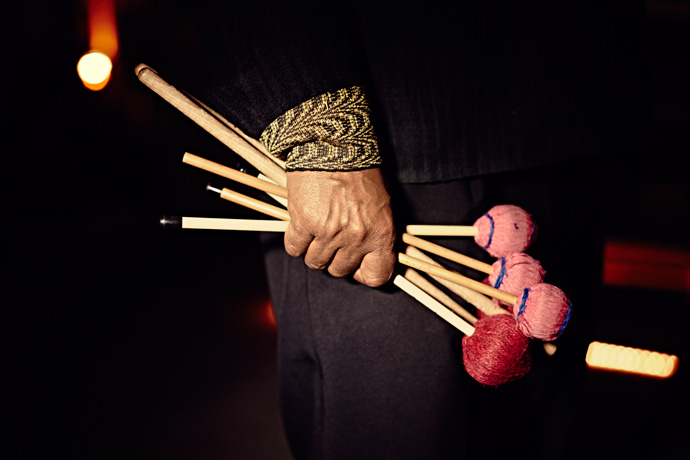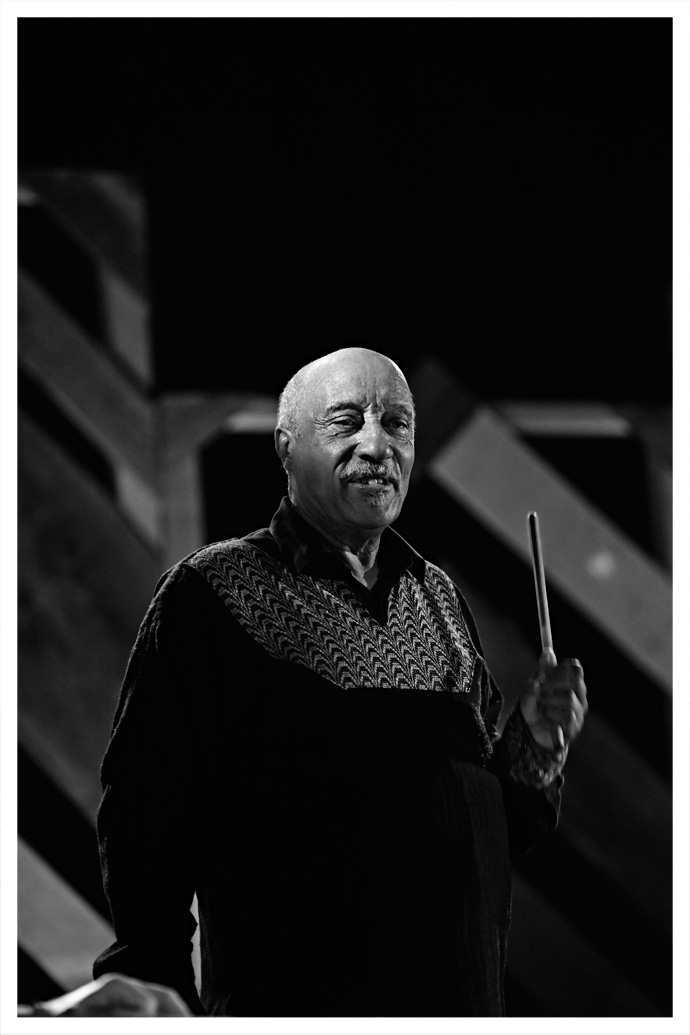-

MULATU ASTATKE: the bushes vs Debussy
-It may have taken decades, but the Ethio-Jazz sounds of Mulatu Astatke are now traveling throughout the world, through Kanye West samples and Jim Jarmusch films, reaching unlikely destinations such as the ecstatic crowds of Calvi On The Rocks in Corsica.
‘Doctor’ Mulatu Astatke as he likes to remind us, is not only a jazzman, but a doctor in musicology, who is eager to add to the lists of achievements of his home country, Ethiopia: coffee, inspiration to the Rastafarian faith, the invention of the musical scale, and it would seem, music conducting.
The bushes. Debussy. In the the mouth of Mulatu Astatke, it’s hard to hear the difference between the two.
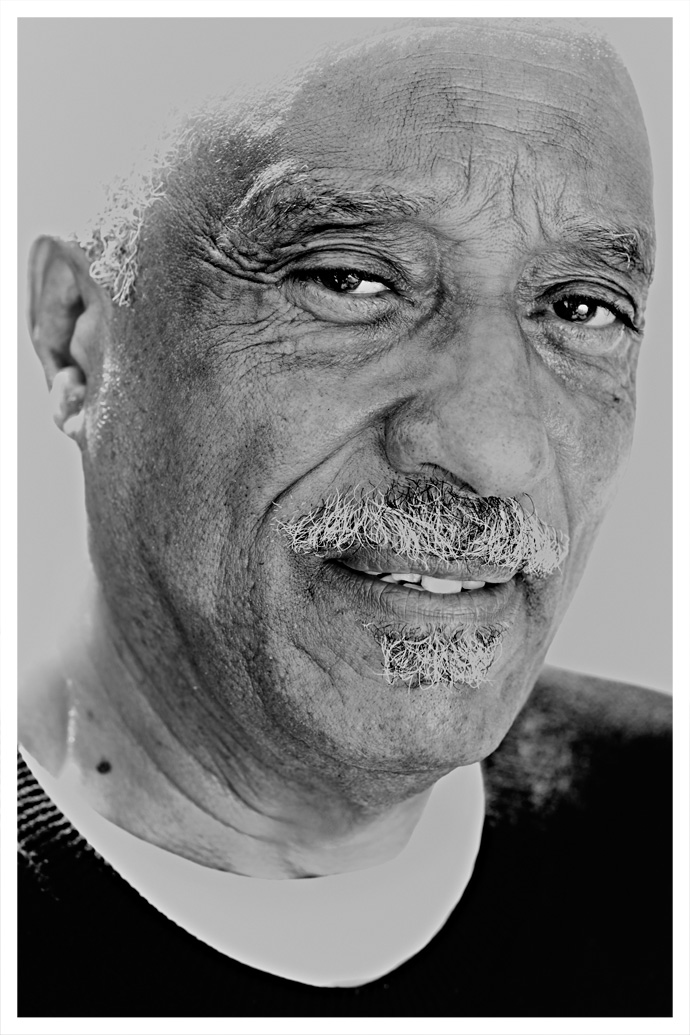
Doctor Mulatu Astatke, "Father of Ethio-Jazz" as his business Card states. Calvi 2013. Photography by René Habermacher.
René Habermacher: How did you come to be part of this festival that is very electronic music related?
Mulatu Astatke: Well, you know, I’ve travelled to Europe a lot in the last 3-4 years. The band became very popular, very busy and we did also a completely beautiful cd which will be coming out in October for the Jazz Village. People seem to ask for my band everywhere.
I used to be involved with electronic music a few years back with Heliocentrics on the album “Inspiration Information” (2009). But I really love acoustic sounds very much: real sounds, real music, everything. It’s good for the people to be able to get both sides, they can hear the acoustic but also the electronic music. I think it’s a very good idea to bring me to this type of festival. It’s great.
RH: How do you feel about the younger generation of pop musicians referring to your sound or even sampling, as in the case of Kanye West and other heavyweights of the contemporary pop generation?
MA: I remember the film “The Broken Flowers” by Jim Jarmusch, with Sharon Stone and Bill Murray. (NB- The soundtrack to the film features an eclectic mix of music, chiefly using instrumentals by Mulatu Astatke as the main score mixed with garage rock, metal and reggae.) The film really made a push and brought different crowds to my audience.
Then people started sampling my music. So my audience keeps on growing. I love it, I have no objection to sampling my music, because every time they sample, the crowds come too.I see all kind of people in London, in Paris, in Australia, everywhere, middle-aged, young, old ages, all kinds of crowd. It helps Ethio-jazz, and also for people to see different directions of music. So it helps so much. I enjoy it. Its beautiful.
Mulatu with drum sticks shortly before going on stage. The composer’s own signature instrument is the vibraphone, a set of graduated aluminum percussion bars that resemble a marimba or a xylophone. Photography by René Habermacher
RH: Ethiopian culture pioneered a lot of different things in music. Your work is part of that tradition.
Do you think because you were so pioneering it took quite some time for the deserved recognition to come in?MA: I put myself as an example and always say: never give up, just keep on pushing!
It’s so great when reality reaches what I always dreamed for this music to reach. If you just get to this point… it took me around 43 years!
The thing which takes time always give great results. It is what it is: as a musician you come to Paris, play Ethio-jazz, you go to NYC, to Germany, Denmark, Sweden, England: playing Ethio jazz.
And then suddenly this music just develops. Its a great recognition.I got my PhD from Berklee (NB – Boston, USA) and lectured in different universities all the time. It’s a great achievement for Ethio-jazz to be accepted at Berklee, a recognition of what we have given to the development of modern music, to dance and everything to the world. So I said: it’s not only for Mulatu, but this is a recognition of Africa, which is so great. So this is what we fight for.
Now I also do a lot of research at Harvard, at MIT and also lecturing for National Geography last month at the Royal Albert hall in London about Ethiopian contribution to culture and music.
I talk about African achievements and what it has given to the worldRH: So the theoretical reflection is very important for you.
MA: Very much! If you don’t know the historical aspect and the contribution of your country’s music, you can’t go any further.
The more you know, the more you do research, the more you enjoy.And the more you can develop the music and show to the world your own contribution.
So research is very important. For example in Ethiopia I go to the rural areas, to the bushes.
There’s one tribe, the Dirashe, who plays a diminishing scale in the middle of a pentatonic five tone scale country like Ethiopia.
In Ethiopia we play only five notes, that’s how Ethio-jazz developed: five notes against the twelve tone scale of American Jazz, you know what I mean. When I studied at Berklee, they were teaching us how Charlie Parker created the modern jazz through diminished scale. But this tribe plays a diminished scale. And great composers like Debussy are on a diminished scale. So what is really very interesting is these tribes have been there for centuries and centuries, so what I want to know is: is it Charlie Parker, was it Debussy, or this tribe ?Who was first? This is the question. These tribes people knew nothing, no painting, nothing, and they play diminished scale. I don’t know how they got it, because they are in the middle of a five note country. How did they manage to get this?
So I raised this question at Berklee and they were so surprised. What they said is: “Oh Mulatu- you got us!”
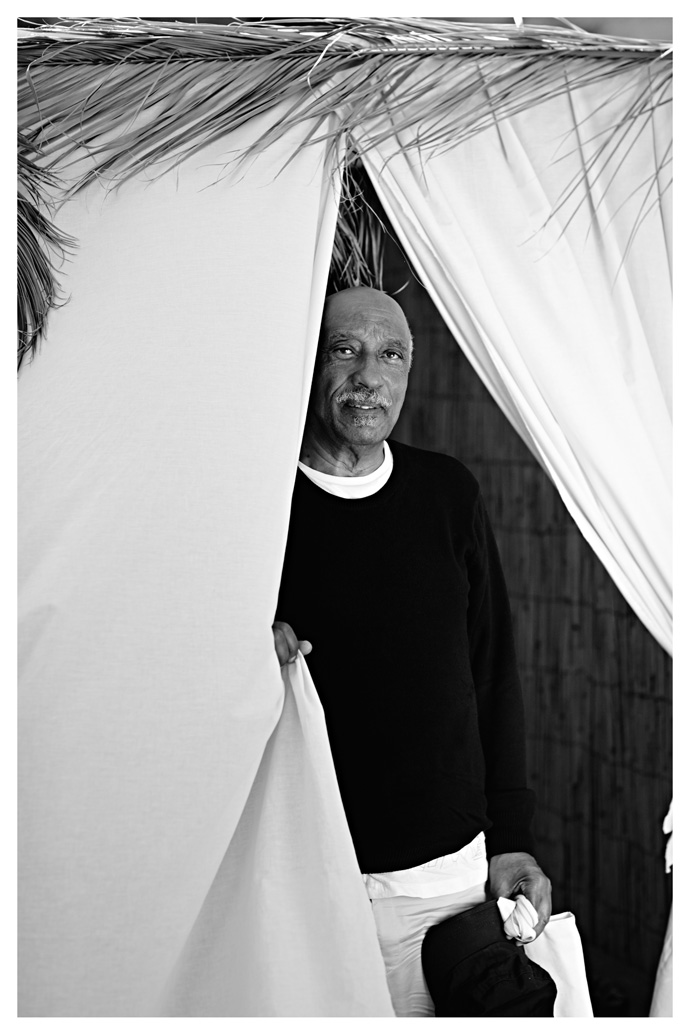 Mulatu Astatke received late recognition: Originally supposed to become an aeronautical engineer he was
the first African student in the late 1950s at Berklee College of Music — “the only place in that time,”
he said, to study jazz. Photography by René Habermacher.
Mulatu Astatke received late recognition: Originally supposed to become an aeronautical engineer he was
the first African student in the late 1950s at Berklee College of Music — “the only place in that time,”
he said, to study jazz. Photography by René Habermacher.RH: Is there a point where you thought the recognition is starting to come?
where you though somebody starts to understand what you were trying to do with Ethio-jazz?MA: In Europe and America, they understand and love my composition all the same. But when I went back from NY to Ethiopia, they didn’t like it at all, because they were used to this musical form that we call the current form: malalala…dalala (sings) I remember a long time ago there was a town that told me to get off stage. It was too complicated to them. They could not understand: “is this a joke or what is it?” Playing around: wabadawadawa?” – they don’t dig it. So I finished the piece and went off.
But now, after 10-15, 20 years they go crazy. The whole town of Addis is Ethio-jazz now.
Finally it’s Ethiopians! So I always say: keep on fighting, never stop. That’s the result.RH: When you worked with those tribes on interpretations, did they have any rejection?
MA: No. You know, I don’t touch them. I just work behind whatever is going on. I can write beautiful counterpoints and harmonies and they do their thing. I just tell them how good they are. What they’ve done to modern music, their contribution to the world. So they love it.
I do a lot of experimental work with this people. I do beautiful jazz fusions with them.
(NB- Mulatu once brought musicians from four different tribes together in an Addis Ababa television studio and orchestrated a cross-tribal fusion performance. This giving traditional musicians, many of them farmers, an artistic exposure beyond their tribes)
The ideal way to explore multiple forms of music is through jazz.
In fact there is a Dirashe track is on my new album, and another one with the Surma tribe.
It’s so interesting, I did an experiment with Fatou (NB- Fatoumata Diawara), the Malian singer who is featured in one song,
a fusion of their music with Ethiopian: east meet west. It’s so beautiful, its on my new album called “Sketches of Ethiopia”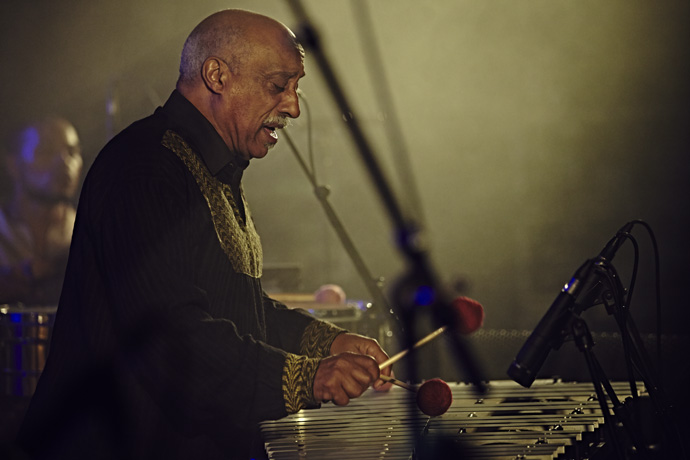
Mulatu in action at Calvi On The Rocks, Corsica 2013. Photography by René Habermacher
RH: Another culture that strongly relates to Ethiopian heritage is the reggae culture, yet in a very different way.
How is your relationship to this?MA: I really respect them for introducing the Ethiopian, the flags and their love to Ethiopia.
But even though musically we’re in different modes, different scales, different things. When you hear Bob (Marley) and the other ones they use mostly their own stuff.
So actually its not like Ethiopian culture or Ethiopian music, but this is their own way of appreciating music. I like them for promoting our country, for promoting our flag in this world, and for it to become like part of national art. We enjoy them, we love them so much! And now, you see they are adding a lot of Ethiopian modes, Ethiopian scales to reggae currently. There are rastas living in Ethiopia in a place called Shashamane.
Hailee Selassie gave them the land in 1948, so they stay there. And now they start to come into our music: Ethio reggae you know.
But now there are more young Ethiopian musicians, they do a lot of reggae. It’s great I think.RH: In 2008 you premiered a portion of the Saint Yared opera at Harvard.
Are you continuing on that project?(NB- The Saint Yared Opera is a project on Saint Yared who is regarded as a saint of the Ethiopian Orthodox Church and credited founder of the Ethiopian Coptic Church Music. He is believed to have been the first to write musical notes, centuries ahead of Western civilisation, and use an ancient form of conducting stick. The composition of the opera will blend the old and the new, and incorporate traditional chant texts in Ge’ez, the Ethiopian liturgical language, but as well electronic elements)
MA: Oh yeah. Thats very interesting. It’s gona be completed very soon. It’s already done actually.
The problem is that l am so busy travelling with other projects: I write for films, I do my experimental works.
I need two to three months to finally put the opera on a stage.This is a work I’ve done at Harvard.
My paper was about conducting being an Ethiopian contribution to the world.
We used to conduct music in the 6th century, with a stick called a mekwamia.Mulatu at Calvi On The Rocks, Corsica 2013. Photography by René Habermacher
So I studied the movement. If you look at the military band march, and the man in front waving sticks and things — 80-90% of that movement is from the mekwamia in Ethiopia.
But where did they get this from? This was before existence of symphony or conducting a symphony — and we have it. If you look inside the Encyclopedia, were there symphony orchestrae in the 6th century? There weren’t.So I said “OK, there were no symphonies, so then the conducting movement is taken from us.” Of course there were a lot of conducting, there were choirs in Europe of all kind.
But the most of the movement is what they use for the military also. If you use in the symphony a stick like this, the way you move it is exactly the same how we move it.
So they are telling us “you can do your reggae, you can do your jazz, you can do your rap.”
But they say classic music is purely European culture, which Africa has nothing to do with.
They are musicologists for Harvard, Yale, Princeton – so I said:
“look, I am open minded. This is what I found. If i am wrong, tell me, I am learning from you.”They couldn’t answer me.
So I say: “one for Ethiopia”. They said: “we’ll see.”[In the opera] there are two great conductors in the symphony, one european with a bow tie, conducting the symphony behind, and a church guy that conducts the choirs.
My dream is to do it in Lalibela (NB- one of Ethiopia’s holiest cities, famous for its monolithic rock-cut churches), the cave.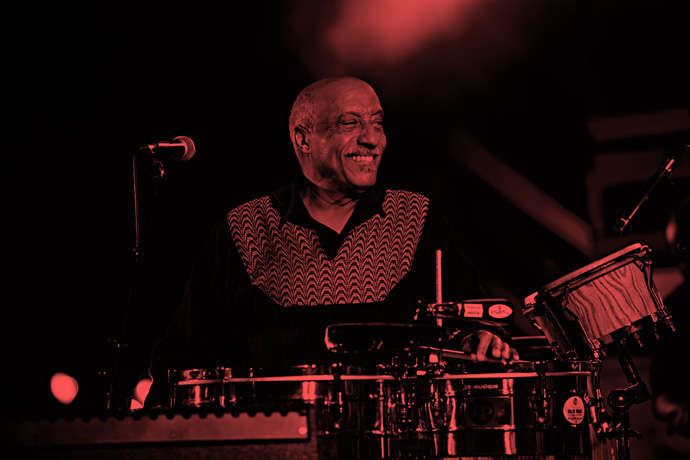
Mulatu at Calvi On The Rocks, Corsica 2013. In the late 1960s he had returned to Ethiopia with the first Hammond Organ and Vibraphones. Photography by René Habermacher
RH: What is the last thing that stimulated you?
MA: That’s really these people in the bushes. They inspire me so much. I have very great respect for them. The more you go closer to them the more you find them so interesting. They have created so many great musical instruments.
Now there are instruments in the bushes they sound like trumpets but made from bamboo. Strings, sound like violins, cellos, that kind of thing.
So I was wondering, let’s do a research – who inspired who ?
When you see these people never had a chance to go anywhere, they have no television, they have no radio, – they have nothing.So I always think they inspire the developing world. Those are the people that inspire me. The more you go everyday, you learn something.
New ideas, something interesting from those people. They inspire me.We call them backwards. But they’re not backwards people to me, they are advanced people.
They are ahead. So this this is my life now. I listen to them.
Whenever I have the chance I am in the bushes, I go close to them.
It’s so interesting, so beautiful. That is what inspires me truly.
Upcoming concert dates:
AUGUST 10 – Paris, Trianon00
